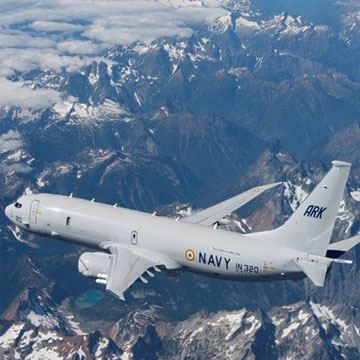 New Delhi:
New Delhi: The Indian Navy released a new Maritime Doctrine in October envisaging an expanded footprint in the Indian Ocean, and besides the aircraft carriers and nuclear powered and nuclear attack submarines, there is appropriate emphasis on offensive naval aviation.
In addition to the the planned 45 MiG 29K combat jets that complement aircraft carrier INS Vikramaditya’s onboard and onshore capability, the most advanced weapon system in the Navy’s arsenal now is the P-8I Neptune Long Range Maritime Reconnaissance (LRMR) aircraft designed to hunt and kill enemy submarines. In fact, in terms of technology and capability, it is the most advanced warfare system in the last several years that any of three Indian Services have acquired.
The Indian Government had ordered eight aircraft with an option for four more soon after the 26/11 attack on Mumbai in 2008 by Pakistani terrorists who infiltrated into the country’s financial capital by sea. Built on the civilian Boeing 737 platform, delivery of all the eight aircraft was recently completed on time and promised costs.
Reliable sources told India Strategic that discussions for four additional aircraft have begun with Boeing, and deliveries would begin soon after the contract is signed.
The Indian Navy has been operating Soviet-vintage IL-38 and Tu-142 maritime surveillance aircraft, and although the IL 38s have been upgraded for limited life extension, the Tu-142s are largely being replaced with the Boeing P-8Is.
The Navy's new Indian Maritime Security Strategy (IMSS 2015), released by Defence Minister Manohar Parrikar in October, supersedes the doctrines released in 2004 and 2009, and substantially increases the Navy’s responsibility in countering both coastal and high seas threats. The area of interest has been expanded deeper south in the Indian Ocean and farther west up to the Mediterranean to ensure safe passage for shipping.
Aircraft are the fastest to reach target areas, and the Boeing P-8I is easier and cheaper to operate in terms of technology and fuel, carries more load than any of the Soviet origin aircraft with the Navy, and has sensors and weapons to detect submarines and other threats 360 degrees. That is why the Navy has decided to exercise the options clause for four more.
Navy Chief Admiral Robin Dhowan had told India Strategic in an earlier interview that besides the 12 P-8Is, the Navy will be looking for nine Medium Range Maritime Reconnaissance (MRMR) aircraft – of the same modern capability as that of P-8I – and 12 Dornier 228 Short Range Maritime Reconnaissance (SRMR) aircraft. The tender for MRMR is yet to be issued.
An older 1980s version of Dornier is being made by HAL and a new generation and more powerful version by the Tata Advanced Systems Ltd (TASL), but the latter is only for exports.
All the aircraft are to have some level of Electronic Warfare (EW) capabilities, and according to Admiral Dhowan, capability is the key towards any selection.
Boeing delivered the last of the eight ordered aircraft in October, and on November 13, Mr Parrikar dedicated the aircraft to the nation after flying in one of them at INS Rajali, Arakkonam, India’s premier naval air station in the southern Indian state of Tamil Nadu, which is under the command of Commander Venkateshwaran Ranganathan.
An engineer by profession, the Defence Minister described the aircraft as a force multiplier in dominating the future battle space and give the Navy the necessary reach and flexibility in swiftly responding to threats in “our area of interest.” He also complimented the Naval A Squadron 312A, which flies them, for achieving several operational milestones even during the induction trials, like participation in the search effort for the missing Malaysian Airlines MH370, and the first successful trial of Harpoon Block II anti-shipping missile made by US company Raytheon.
Raytheon has also given the multi-mission aircraft a highly sophisticated Advanced Electronically Scanned Array (AESA) APY-10 radar. The P-8I has 360 degree surveillance capability for Electronic Signals Intelligence (ELINT), thanks to radars from Raytheon and Telephonics, while its weapons include depth charges, torpedoes and missiles.
The P-8I Neptune for the Indian Navy is nearly the same as the P-8 Poseidon for the US Navy, except for some changes like India’s own data link made by BEL which the Navy uses for all its ships and stations.
"The Boeing teams have been committed to building, delivering and supporting this aircraft for our important customer - the Indian Navy. Over the last six years, we have learned together, grown together and cemented a foundation for a long-term relationship that will last decades. To see this aircraft come to life at INS Rajali and perform the missions it was envisioned to do under the very able handling of the Indian Navy's sailors and officers has been truly amazing," Bell observed.
 New Delhi: The Indian Navy released a new Maritime Doctrine in October envisaging an expanded footprint in the Indian Ocean, and besides the aircraft carriers and nuclear powered and nuclear attack submarines, there is appropriate emphasis on offensive naval aviation.
New Delhi: The Indian Navy released a new Maritime Doctrine in October envisaging an expanded footprint in the Indian Ocean, and besides the aircraft carriers and nuclear powered and nuclear attack submarines, there is appropriate emphasis on offensive naval aviation.